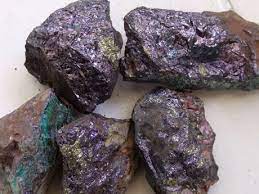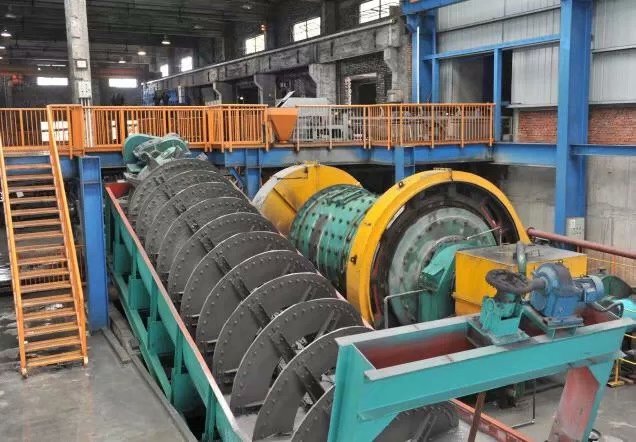The beneficiation process of molybdenum ore is mainly performed by flotation separation methods, and the recovered molybdenum mineral is molybdenite(MoS2). Sometimes in order to improve the quality of molybdenum concentrate and remove impurities, the concentrated molybdenite would be subjected to a further step of beneficiation processing.
About Molybdenum Ore

Common molybdenum ores mainly include single molybdenite, molybdenum-containing polymetallic ore and high oxidation rate molybdenum ore. Different molybdenum ore types have different grades and properties, which also determines their beneficiation methods are also different. For example, talc-containing molybdenum ore or copper-molybdenum ore, highly oxidized molybdenum ore, and disseminated finer or ultra-fine molybdenum ore and other types, the grade is about 0.08%, and this type of molybdenum ore is usually very difficult to separate.
Molybdenum ore with a grade above 0.1% is often associated with valuable metals such as gold, silver, and lead, and its development and utilization value is often more obvious.
Molybdenum Ore Benefciation Process
Molybdenite flotation processing plant
During overgrinding, the proportion of S-Mo surface increases and the floatability decreases. Although a certain amount of polar collectors such as xanthates are added at this time, it is beneficial to the recovery of molybdenite, but the new sludge produced by overgrinding will affect the flotation effect. Therefore, the separation of molybdenite should avoid and prevent over-grinding. In the production, it is necessary to adopt segmented grinding and multi-stage separation processes to gradually achieve monomer dissociation and ensure a high recovery rate of molybdenum concentrate. The crushing of molybdenum ore generally uses a three-stage one-closed-circuit process, and the final product size is 12-15 mm.
Usually use the ball mill or rod mill-ball in the ore milling process. But there are also some processing flows adapted to use a semi-self-grinding process. Flotation separation adopts priority flotation method. Rough separation produces coarse molybdenum concentrate, and rough sweeping tailings recover associated minerals or discard. The coarse molybdenum concentrate is reground in two or three stages, and the final molybdenum concentrate is obtained by four or five times of selection.
The flotation reagent of molybdenum ore uses non-polar oils as collectors, while adding foaming agents. The United States and Canada use the surfactant Syntex as an oil emulsifier. According to the nature of the ore, lime is used as a regulator, water glass is used as a gangue inhibitor, and sometimes cyanide or sulfide is added to inhibit other heavy metal minerals.

How to improve concentration quality
1. In order to ensure the quality of molybdenum concentrate, the heavy metal minerals such as copper, lead and iron contained in molybdenum concentrate and calcium oxide and carbon minerals need to be further separated:
- Generally use sodium sulfide or sodium hydrosulfide, cyanide or ferricyanide Make copper and iron; use dichromate or Nokes to suppress lead.
- If inhibitors are used, the impurity content is not up to the quality standard, and chemical beneficiation treatment is needed: secondary copper sulfide is leached with cyanide; chalcopyrite is leached with ferric chloride solution; galena is with hydrochloric acid and trichloride The iron leaching solution can reach the standard content.
2. Calcium oxide-containing gangue is easy to mud. Therefore, over-grinding of ore containing this kind of gangue should not be avoided. In production, water glass, sodium hexametaphosphate or organic glue is often added as gangue inhibitor or dispersant; activated carbon and CMC (carboxymethyl cellulose) can also be used to inhibit carbonate gangue. Finally, it can be leached with hydrochloric acid or hydrochloric acid plus ferric chloride solution.
3. In the separation of carbonaceous minerals, it is first necessary to find out whether the carbonaceous is graphite, pitch or coal. The floatability of these carbonaceous minerals is similar to that of molybdenite, but the density is relatively small, and generally can be removed by gravity separation; use sodium hexametaphosphate and CMC to inhibit carbon floating molybdenum; or add ferric chloride, water glass And sodium hexametaphosphate is also effective in inhibiting carbon quality; roasting to remove organic carbon is also one of the methods. It should be pointed out that the separation methods of all these carbonaceous minerals are not yet satisfactory, and it is still an unsolved problem.
Factors that affects the concentrates grade
The high content of SiO2 (silicon dioxide) in gangue is often the reason that affects the grade of molybdenum concentrate.
It has been verified that the content of SiO2 decreases as the grade of molybdenum concentrate increases, and the two tend to consume each other. As long as the molybdenum mineral reaches the monomer dissociation fineness, the SiO2 content can generally be reduced below the standard. Adding activated carbon to adsorb the oil on the surface of molybdenum, and adding CMC to inhibit silicate gangue, the SiO2 content can also be reduced to below the standard.
The level of economic benefits of specific molybdenum ore beneficiation has an important relationship with the conditions of the mineral itself. Of course, scientific and reasonable mineral processing technology and advanced and excellent mineral processing equipment are naturally the main plus points for the user’s economic benefits. JXSC can tailor the beneficiation process suitable for your nickel ore. At the same time, our beneficiation equipment is complete in model, hard in quality, excellent in performance and low in price.